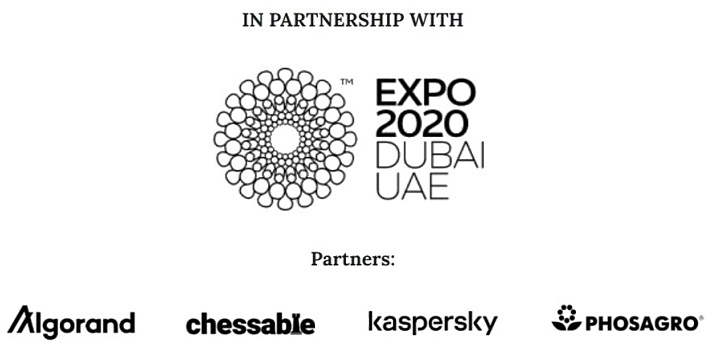Game two of the FIDE World Championship gave viewers a glimpse of what may be a pivotal over-the-board battlefield as titleholder Magnus Carlsen set the pace with the advantage of the first move today. As the players were introduced to the audience, there was a few minutes delay before the champion emerged onstage.
Once again FIDE President Arkady Dvorkovich made the ceremonial first move on the board, again flanked by two special guests: Andrey Simanovsky, President of the Chess Federation of the Sverdlovsk region, whose company Sima Land has sponsored the Candidates tournament and the Online Olympiad; and Alexander Filatov, co-founder and CEO of TON Labs, a FIDE NFT (non-fungible token) partner behind the joint launch of the ChessNFT marketplace.
In the isolation of their soundproofed stage, and blind to the audience outside behind one-way glass, the hostilities of game two commenced. Fully focused, the champion chose to play the Catalan Opening against challenger Ian Nepomniachtchi, and just as in game one, there was an intriguing psychological dance in the first phase of play.

Opening duel
Once again Carlsen was the first to hesitate, but like the day before, this seemed to be him consulting his mental database. He chose a sharp and unusual reply, sacrificing a pawn for active play, again echoing his decision in game one. This plunged the challenger into long thought surprisingly early, and it soon appeared that Carlsen had succeeded in snaring his opponent in a dangerous line doubtless prepared in his training camp.
US grandmaster Fabiano Caruana, the previous world title challenger, called the development of the first stage of the game for the challenger as “any player’s ultimate nightmare ” – getting caught in a sharp position of your opponent’s preparation. “Again, Magnus has won the opening battle,” Caruana concluded.
Although it is too early to declare a trend after two games, it is impossible to ignore the unexpected sight of the supposedly quiet Carlsen intent on sacrificing material to create pressure and a more solid stance from the normally aggressive challenger. This might break the apparent mould of how their styles are easily summarized, but it does echo their previous history, where Magnus has overpressed with the white pieces trying to show his problem opponent who is boss.

Despite the fierce early pressure on Nepomniachtchi, the immense complexity of the position meant that one slip from Carlsen could swing the balance – and that slips were in high supply.
Slips
Experts pointed to Carlsen’s 17th (17.Ne5) move as inaccurate, and there was visual confirmation as the challenger suddenly began to play at his patented high speed, while the champion began to burn thinking time, realizing that he would have to sacrifice even more material to avoid a grim defence. This further investment would mean that defeat would loom large if Carlsen could not generate enough pressure to compensate.
As the pace slowed and experts had time to grapple with the complications, a vague consensus emerged that Nepomniachtchi had seized the upper hand but that the position remained extremely difficult to play. The human factor would likely decide, especially as their thinking time ticked towards zero.

High drama
The challenger appeared to let some of his edge slip with some patented swift play, and as the position began to clarify, the champion clawed his way to safety. Then, according to some grandmaster observers, the champion even held the possibility of pressing once again for a win. In the end, Carlsen actually managed to emerge with a pawn advantage in a rook endgame, but in a position well known to be easily drawn, the point was destined to be split.
The verdict
Game two was a breathtaking clash, with champion Carlsen getting an early grip on both board and clock. Challenger Nepomniachtchi was creative and resourceful in defence, turned the tables, and then probably let his rival off the hook with a few rushed decisions. Once the position stabilized, the game finally reached a predictable scenario – a subtle technical position where Carlsen often manages to make something out of next to nothing – but not against Nepomniachtchi today.
In a brief discussion about the game after the draw was agreed, the players compared thoughts about the baffling complications, and Magnus could be heard to say: that he hadn’t been sure who had been better or why – a telling summary of an exceptionally dramatic fighting game.

The players confirmed this in the post-game press conference, with Magnus admitting he had totally overlooked Ian’s 18th move, and that he then realized he was in danger rather than in the ascendancy. Ian said it was “in general a very puzzling game” and labelled it chaotic and crazy.
Carlsen summarized the match so far as ‘atypical of both players’, explaining that the games were just fights and that it might settle down later.
The question of colours
Although the advantage of the first move carries a clear statistical superiority, it is quite common for the reverse possibility to come up for debate during a title match – might there be more positives to playing with the black pieces in the unusual setting of a lengthy one-on-one duel?
This debate is usually sparked due to the incredibly high level of preparation for world championship matches, and a few simple considerations. The most important factor is that there are always a large number of defensive systems, and Black only has to choose a few and prepare these deeply. The player with white has to try and predict where the battle will take place and cannot be as deeply prepared in advance – for everything.

Historically, this often resulted in some probing in the early stages, with the white player gradually and cautiously discovering where his opponent had decided to fight. The bigger this surprise, the more problematic for the attacker. Now, with shorter modern matches and incredibly sophisticated computer analysis, there is less time to readjust to surprise, and this can give the impression that having black is no handicap at all.
But, in each individual game, white remains the innate favourite, and black’s first mission is always to neutralize the head start of the first move before thinking about winning. And if white lands the surprise or unleashes a bold new idea, this can simply be lethal.
Local colour
Earlier in the day, the Dubai Exhibition Hall hosted yet another world chess champion, when Garry Kasparov toured the playing area and theatre as the guest of His Excellency Sheikh Nahayan Mabarak Al Nahayan, the Minister of Tolerance and Coexistence, and commissioner general of Expo2020.

FACT SHEET, Game 2, FIDE (International Chess Federation) World Championship:
White: Magnus Carlsen
Black: Ian Nepomniachtchi
Result: ½-½
Game length: 58 moves
Match score: 1-1
Opening: Catalan
Time control: 40 moves in two hours (each), an additional hour (each) to reach move 60, then an additional 15 minutes (each), plus 30 seconds added per move after move 60. Exceeding the time limit loses the game.
Trivia: ‘The Catalan Opening was first played in 1929, by (Savielly) Tartakower – in connection with the Barcelona Expo’ – leading Spanish chess journalist Leontxo Garcia. So there is an echo of Expos, from Barcelona to Dubai.
Text: Jonathan Tisdall, Press Officer press@fide.com
Photo: Eric Rosen and Niki Riga
Official website of FIDE World Championship Dubai 2021


